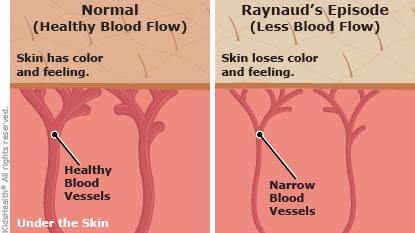- Parents Home
- Para Padres
- A to Z Dictionary
- Allergy Center
- Asthma
- Cancer
- Diabetes
- Diseases & Conditions
- Doctors & Hospitals
- Emotions & Behavior
- First Aid & Safety
- Flu (Influenza)
- Food Allergies
- General Health
- Growth & Development
- Heart Health & Conditions
- Homework Help Center
- Infections
- Newborn Care
- Nutrition & Fitness
- Play & Learn
- Pregnancy Center
- Preventing Premature Birth
- Q&A
- School & Family Life
- Sports Medicine
- Teens Home
- Para Adolescentes
- Asthma
- Be Your Best Self
- Body & Skin Care
- Cancer
- Diabetes
- Diseases & Conditions
- Drugs & Alcohol
- Flu (Influenza)
- Homework Help
- Infections
- Managing Your Weight
- Medical Care 101
- Mental Health
- Nutrition & Fitness
- Q&A
- Safety & First Aid
- School, Jobs, & Friends
- Sexual Health
- Sports Medicine
- Stress & Coping
Raynauds Syndrome
What Is Raynauds Syndrome?
Raynauds syndrome is a condition that makes a person's fingers or toes temporarily feel cold, numb, tingly, or painful. When a child has a Raynauds (ray-NOZE) episode, blood vessels under the skin become narrow, so less blood gets to the affected area.
What Are the Signs & Symptoms of Raynauds Syndrome?
Raynauds syndrome usually affects fingers and toes. Less often, episodes can affect the nose, ears, lips, nipples, or knees.

During an episode, the skin will:
- get very pale or white
- turn bluish or purplish
- look rosy or red as the person starts warming up
The skin usually changes from white to blue or purple, then to red. But in some kids, all these colors may not happen, or the colors may happen in a different order.
Episodes can happen when a child is exposed to cold or is under emotional stress. The cold or stress is called a trigger. Episodes usually end within about 15 minutes after a child warms up or calms down.
Who Gets Raynauds Syndrome?
Doctors usually don't know what causes Raynauds. But the condition is more likely to happen in people who:
- have certain medical conditions, such as lupus or other diseases
- have relatives with Raynauds
How Is Raynauds Syndrome Treated?
Kids with Raynauds often can ease the symptoms by doing things on their own. For example, to warm fingers or toes during an episode, they can:
- Move to a warmer location.
- Swing their arms in circles.
- Wiggle the fingers or toes.
- Place their hands or feet in warm (not hot) water.
- Place their hands against a warm part of the body (such as the armpits).
- Rub their hands together or massage the feet.
If Raynauds is severe or causes problems, doctors may prescribe medicine to help.
How Can Parents Help?
If your child has Raynauds:
- Encourage your child to get exercise. This can help with circulation.
- Prepare for the weather:
- When it's cold outside, have your child wear warm, loose layers; thick socks; a hat; and gloves or mittens (mittens help keep fingers warmer).
- In warm weather, your child should have a sweater or jacket available to wear in air-conditioned places.
- Help your child avoid things that can make Raynauds worse, such as:
- smoking and secondhand smoke
- caffeine
- stress
- tight-fitting rings, bracelets, or shoes, because these can make it harder for blood to move through blood vessels in the area
- Teach your child to do relaxation exercises. This can be helpful for managing stress, especially if stress triggers episodes in your child.

© 1995- The Nemours Foundation. KidsHealth® is a registered trademark of The Nemours Foundation. All rights reserved.
Images sourced by The Nemours Foundation and Getty Images.
Humana Healthy Horizons in Ohio
- Humana Healthy Horizons
- Humana Healthy Horizons Extras
- Member Support
- Care management
- Caregiver resources
- Child well-being
- Disease management
- Documents and forms
- Enrollment
- Grievances and appeals
- Health and wellness
- KidsHealth
- Member Handbook
- New Member Resources
- News and alerts
- OhioRISE Plan
- Pregnancy outcomes
- Tobacco cessation
- Why Humana
- Your primary care provider
- For Providers
- Contact us
- Accessibility
- Humana Healthy Horizons
- Humana Healthy Horizons Extras
- Member Support
- Care management
- Caregiver resources
- Child well-being
- Disease management
- Documents and forms
- Enrollment
- Grievances and appeals
- Health and wellness
- KidsHealth
- Member Handbook
- New Member Resources
- News and alerts
- OhioRISE Plan
- Pregnancy outcomes
- Tobacco cessation
- Why Humana
- Your primary care provider
- For Providers
- Contact us
- Accessibility